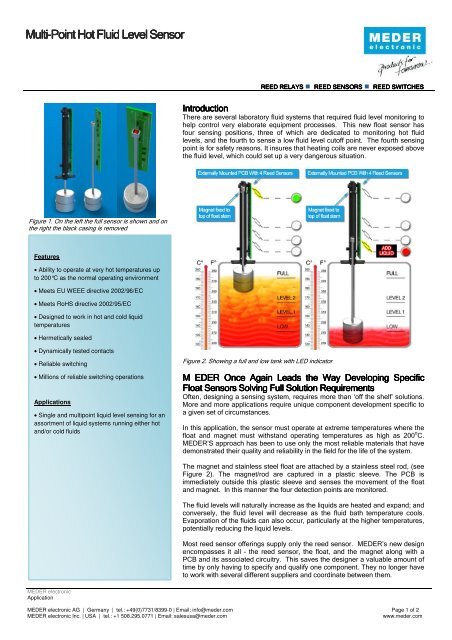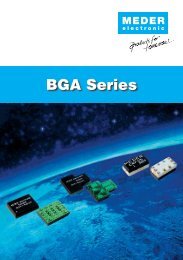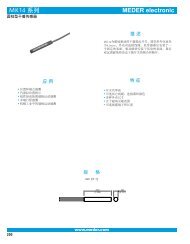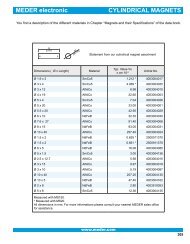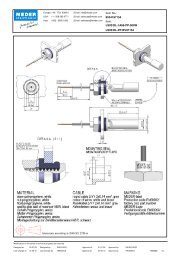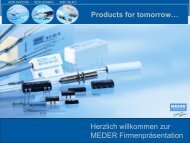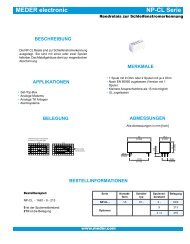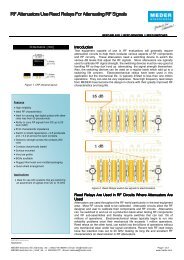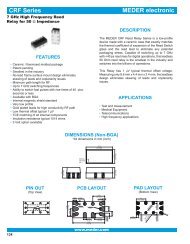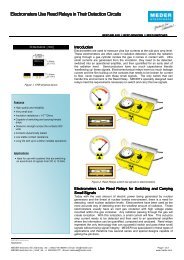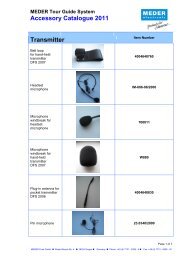Multi-Point Hot Fluid Level Sensor - Digi-Key
Multi-Point Hot Fluid Level Sensor - Digi-Key
Multi-Point Hot Fluid Level Sensor - Digi-Key
You also want an ePaper? Increase the reach of your titles
YUMPU automatically turns print PDFs into web optimized ePapers that Google loves.
<strong>Multi</strong> <strong>Multi</strong>-<strong>Point</strong> <strong>Multi</strong> <strong>Point</strong> <strong>Hot</strong> <strong>Hot</strong> <strong>Fluid</strong> <strong>Fluid</strong> <strong>Level</strong> <strong>Level</strong> <strong>Sensor</strong><br />
<strong>Sensor</strong><br />
Figure 1. On the left the full sensor is shown and on<br />
the right the black casing is removed<br />
Features<br />
• Ability to operate at very hot temperatures up<br />
to 200°C as the normal operating environment<br />
• Meets EU WEEE directive 2002/96/EC<br />
• Meets RoHS directive 2002/95/EC<br />
• Designed to work in hot and cold liquid<br />
temperatures<br />
• Hermetically sealed<br />
• Dynamically tested contacts<br />
• Reliable switching<br />
• Millions of reliable switching operations<br />
Applications<br />
• Single and multipoint liquid level sensing for an<br />
assortment of liquid systems running either hot<br />
and/or cold fluids<br />
MEDER electronic<br />
Application<br />
Introduction<br />
Introduction<br />
Introduction<br />
REED REED REED RELAYS RELAYS � REED REED REED SENSORS SENSORS � REED REED SWITCHES<br />
SWITCHES<br />
There are several laboratory fluid systems that required fluid level monitoring to<br />
help control very elaborate equipment processes. This new float sensor has<br />
four sensing positions, three of which are dedicated to monitoring hot fluid<br />
levels, and the fourth to sense a low fluid level cutoff point. The fourth sensing<br />
point is for safety reasons. It insures that heating coils are never exposed above<br />
the fluid level, which could set up a very dangerous situation.<br />
Figure 2. Showing a full and low tank with LED indicator<br />
M EDER Once Again Leads the the Way Developing Specific<br />
Float Float Senso <strong>Sensor</strong>s Senso rs Solving Solving Full Full Full Solution Solution Requirements<br />
Requirements<br />
Often, designing a sensing system, requires more than ‘off the shelf’ solutions.<br />
More and more applications require unique component development specific to<br />
a given set of circumstances.<br />
In this application, the sensor must operate at extreme temperatures where the<br />
float and magnet must withstand operating temperatures as high as 200 o C.<br />
MEDER’S approach has been to use only the most reliable materials that have<br />
demonstrated their quality and reliability in the field for the life of the system.<br />
The magnet and stainless steel float are attached by a stainless steel rod, (see<br />
Figure 2). The magnet/rod are captured in a plastic sleeve. The PCB is<br />
immediately outside this plastic sleeve and senses the movement of the float<br />
and magnet. In this manner the four detection points are monitored.<br />
The fluid levels will naturally increase as the liquids are heated and expand; and<br />
conversely, the fluid level will decrease as the fluid bath temperature cools.<br />
Evaporation of the fluids can also occur, particularly at the higher temperatures,<br />
potentially reducing the liquid levels.<br />
Most reed sensor offerings supply only the reed sensor. MEDER’s new design<br />
encompasses it all – the reed sensor, the float, and the magnet along with a<br />
PCB and its associated circuitry. This saves the designer a valuable amount of<br />
time by only having to specify and qualify one component. They no longer have<br />
to work with several different suppliers and coordinate between them.<br />
MEDER electronic AG | Germany | tel.: +49(0)7731/8399-0 | Email: info@meder.com Page 1 of 2<br />
MEDER electronic Inc. | USA | tel.: +1 508.295.0771 | Email: salesusa@meder.com www.meder.com
<strong>Multi</strong> <strong>Multi</strong>-<strong>Point</strong> <strong>Multi</strong> <strong>Point</strong> <strong>Hot</strong> <strong>Hot</strong> <strong>Fluid</strong> <strong>Fluid</strong> <strong>Level</strong> <strong>Level</strong> <strong>Sensor</strong><br />
<strong>Sensor</strong><br />
Specifications Specifications (@ (@ 20 20°C) 20 C)<br />
LSS Series Series<br />
Operate Operate specs specs Min Min Max Max Units<br />
Units<br />
Must Must close close distance distance Ref Ref mm<br />
Must Must open open distance<br />
distance<br />
Hysteresis<br />
Hysteresis<br />
MEDER electronic<br />
Application<br />
Ref Ref mm<br />
Load Characteristics Min Max Units<br />
Switching voltage 200 V<br />
Switching current 0.5 Amps<br />
Carry current<br />
1.0 Amps<br />
Contact rating 10 Watts<br />
Static Contact<br />
resistance<br />
150 mΩ<br />
Dynamic contact<br />
resistance<br />
200 mΩ<br />
Breakdown voltage 200 V<br />
Operate time 0.6 msec<br />
Release time 0.05 msec<br />
Operate Temp<br />
(float and magnet)<br />
-10 200 °C<br />
Storage Temp -25 75 °C<br />
REED REED REED RELAYS RELAYS � REED REED REED SENSORS SENSORS � REED REED SWITCHES<br />
SWITCHES<br />
Since this sensor requires some electrical circuitry, using a printed circuit board<br />
with plated thru solder holes guarantees reliable connections using an<br />
automated wave soldering systems. The hermetically sealed reed switches are<br />
properly placed and positioned in their predetermined sensing locations.<br />
Another critical element is the acknowledgement that during assembly,<br />
problems can occur. MEDER tests all sensors 100% for all operating<br />
conditions, but in addition, tests for dynamic contact resistance (DCR).<br />
Essentially this test is a guard against the many faults that can occur during<br />
assembly. If the reed contacts have any internal contaminations; or the reed<br />
capsule has been stressed or a slight crack has occurred, the DCR test will<br />
detect these conditions and reject the sensor. This testing is carried out in an<br />
automated testing system. MEDER’s design for manufacturing approach<br />
provides a long reliable life in the field.<br />
Consult our engineering group with your specific applications.<br />
Adaptable Adaptable Liquid Liquid <strong>Level</strong> <strong>Level</strong> Series<br />
Series<br />
Ser Series Ser ies Dimensions Dimensions<br />
Illustration Illustration<br />
Illustration<br />
mm inches<br />
inches<br />
KSS KSS-BV15178<br />
KSS KSS BV15178 W<br />
25 0.984<br />
MEDER electronic AG | Germany | tel.: +49(0)7731/8399-0 | Email: info@meder.com Page 2 of 2<br />
MEDER electronic Inc. | USA | tel.: +1 508.295.0771 | Email: salesusa@meder.com www.meder.com<br />
H<br />
L<br />
LS04 LS04<br />
W<br />
LS05<br />
LS05<br />
H<br />
L<br />
W<br />
H<br />
L<br />
Liquid Liquid <strong>Level</strong> <strong>Level</strong> Series<br />
Series<br />
25 0.984<br />
165 6.496<br />
25 0.984<br />
25 0.984<br />
165 6.496<br />
0.276-<br />
7-16 0.630<br />
0.276-<br />
7-16 0.630<br />
80- 3.150-<br />
2000 78.740<br />
Series Series Dimensions Dimensions<br />
Illustration<br />
Illustration<br />
mm inches<br />
inches<br />
LS01 LS01<br />
W 19 0.748<br />
H 24 0.945<br />
L 42 1.654<br />
LS02 LS02 LS02<br />
W 19 0.748<br />
H 24 0.945<br />
L 75 2.953<br />
LS03 LS03<br />
W 25 0.984<br />
H 25 0.984<br />
L 80 3.150<br />
** **Consult **<br />
the factory for more options not listed above.


